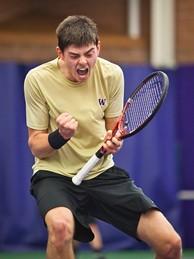
The Intercollegiate Tennis Association (ITA) is the governing body of college tennis, overseeing men's and 
The ITA administers the USTA/ITA Regional Championships. Close to 8,000 men's and women's collegiate tennis players participate each year in over 80 regional events (24 for Division I and approximately 60 for small colleges), which are hosted across the country throughout September and October. In addition, ITA administers a year-round calendar of events including a Summer Circuit.
 Sports Destination Management: The ITA includes a wide range of schools with tennis programs. What kind of participation numbers are you seeing?
Sports Destination Management: The ITA includes a wide range of schools with tennis programs. What kind of participation numbers are you seeing?
Timothy Russell: We’re still trying to get a handle on the exact number. We think there are between 17,000 and 20,000 student-athletes.
SDM: Is participation growing?
Russell: Our hope, of course, is to keep the numbers growing. In reality, though, they seem to have been staying the same. College athletics is an environment that traditionally favors football and basketball, so you’re competing against those when it comes to funding. Non-revenue sports like tennis have to constantly prove themselves in order to stay relevant. We work with our coaches and give them ideas about how they and their teams can help prove they are necessary and relevant. For example, they can work with underprivileged kids, with junior tennis – the idea is to make the sport so embedded on campus and in their community that nobody would want to cut it.
SDM: What challenges do you see college tennis facing?
Russell: The threats to tennis aren’t necessarily coming from another sport. The biggest threat might be that we don’t have enough young people coming up and coming into the sport. Tennis is a sport that takes a great deal of skill to be good at, and it’s an expensive sport as well.
SDM: Do you think club and recreational tennis programs, such as USTA Tennis On Campus, constitute a threat to varsity tennis programs?
Russell: I would not call it a threat. Some might, of course. I am one who is of the philosophy that a rising tide raises all boats. The reality is this: the Tennis On Campus program has become very successful and that means more people playing tennis in college. That keeps the sport healthy.
SDM: After graduation, what do you see college players going on to do? Do they stay in tennis?
Russell: One of the things you hope for is that people will go on playing after college. We see a small percentage that goes on and plays pro tennis, but more importantly, we see a lot who go on to be America’s leaders – they are COOs, CEOs and so on. Our intuitive observation has been that a good number of student-athletes might stop playing briefly after college, but they do end up coming back to the game and playing in leagues; the USTA has a very strong league program.
What’s interesting is that some areas have done a really great job of connecting adult players after college by using the social aspect of the game. Phoenix, for example, has a very successful program for people called Sets in the City. It couples informal tennis play with social events, and allows people to play and hang out.
 SDM: The ITA sponsors a number of tournaments during the year. What does it look for in locations?
SDM: The ITA sponsors a number of tournaments during the year. What does it look for in locations?
Russell: Running a high-level tennis tournament is a big deal, and there are locations that have done a great job and have built up an amazing infrastructure. In some cases, you have events that will stay in the same location each year.
When you’re looking at a possible location for a tournament, there are a lot of criteria you factor in. Of course, you’re looking for places that have enough courts, as well as enough volunteers and enough officials in the area. Then, especially for national tournaments, you need access to major airports. Sometimes it’s a balancing act when it comes to location; you’ll have cities that aren’t near a major airport but that do have plenty of courts and volunteers. What’s good is that lots of cities are interested in hosting now because of the economic impact these tournaments bring ito bear on their communities.
SDM: If a city is interested in hosting, how should they get in touch?
Russell: They can go to the staff directory on our website and get in touch with Cory Brooks, our director of championships.
SDM: Judging from the tournament scene, it certainly looks like tennis at the collegiate level is alive and well.
Russell: This is a very exciting time in the world of college tennis. There’s a lot of renewed energy in our sport.


